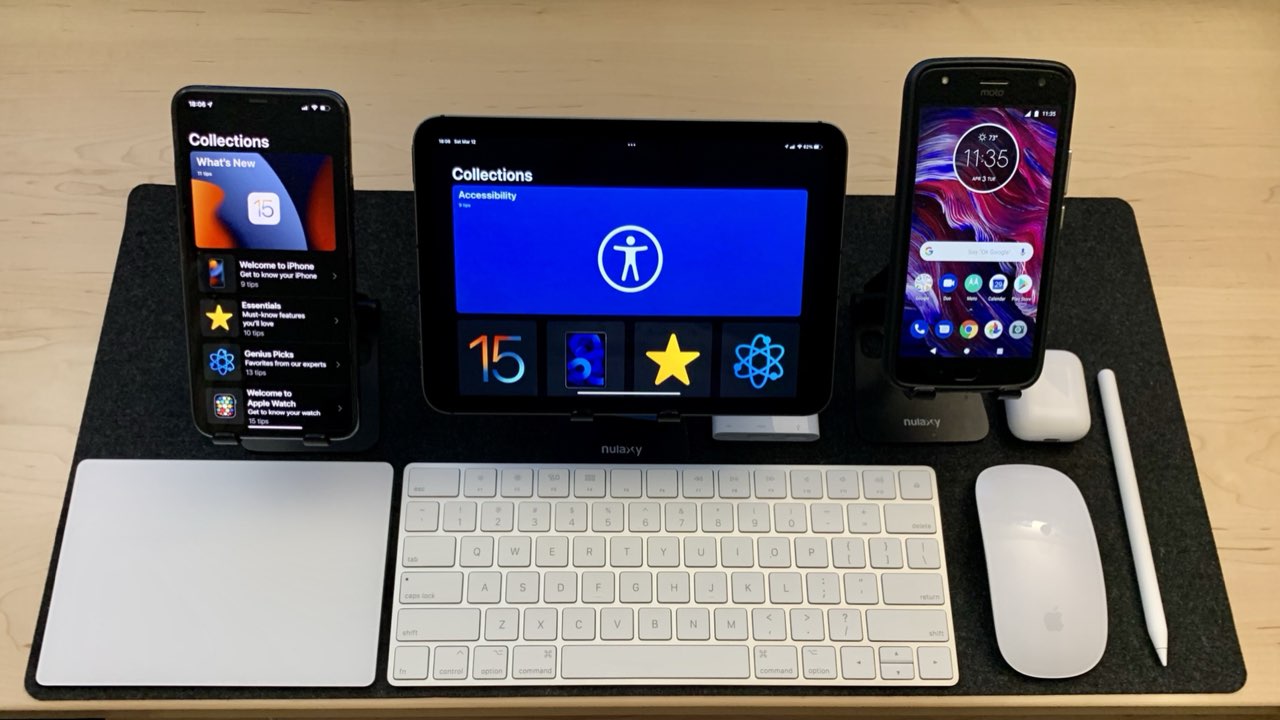GREETINGS!
Thanks for taking a moment to read this month’s update. The photo featured above was taken today and shows my latest desktop computing devices. Note that the screen image used on the Moto X phone (on right) is a stock image for that model of phone, so the date shown on that screen isn’t accurate. I downloaded it to the phone and zoomed in on it, since the home screen on that phone no longer looks like the original.
Simple Tech Devices
Last year I wrote about the importance of embracing simpler tech devices in 2022. [View Advisory] I’ve been promoting this message with everyone who comes to me for tech support. Reducing our dependency on devices, and choosing simpler devices can reduce the time, expense, and stress of technology.
This month’s update is being written using the iPad you see pictured above. It is an iPad mini and the first iPad I’ve had that has a USB-C port. Not shown in the picture is the 42-inch (diagonal) 4K Samsung display with 777-square-inches of display surface area. The iPad mini has 31.5-square inches of display surface area for the 8.3-inch diagonal screen.
Common sizes for big screen TVs would be 52-inches up to about 72-inches. So, the 42-inch display is considered to be on the lower end. I purchased it years ago as a primary desktop display. The reason I chose the smaller less expensive display is because for close-up work, the 4K resolution (2266 x 1488 pixels) looks much sharper when condensed onto a small screen.
The iPad mini functions well on its own without any other accessories, but having a keyboard, external display, mouse, and trackpad help create a desktop computing experience from the small iPad that’s about 5.3-inches by 7.7-inches in size and 1/4-inch thick. With a USB-C hub, the iPad mini can have just about every device imaginable connected. [View Example] For daily portability, I carry the iPad and keyboard which function like a small laptop computer. At home, I switch between portable use and desktop use.
I maintain a resource page for the Raspberry Pi computer. [View] It is the system on a chip (SOC) used for a DIY assembled home computer. A few years ago, the Pi computer could be purchased for about $35, making it one of the least expensive computers in the world. With advances in the features, and now being in high demand globally, the cost is up to about $200 just for the circuit board. A display, keyboard, mouse, and USB-C power adapter would also be needed.
The latest entry-level 10.2-inch iPad is about $330 [Learn More] and only needs a Bluetooth keyboard for about $40. [View All | View My Favorite] If you don’t mind using the iPad’s on-screen touch keyboard, then you can skip the cost of buying an external one. The basic $330 iPad can handle the tasks that most people need to accomplish — word processing, email, watching videos, reading books, reading news, printing, and more.
In addition to being relatively inexpensive to purchase, and inexpensive to maintain (fewer bills for tech support), the iPad is a low power device that works well during power outages from its built-in battery or a large reserve power pack. [View Examples]
I’m exploring these low-tech devices so I can give people the best advice on simple low-cost tech choices.
TECH WORK
My tech support workload continues to be quite busy, but I’m happy to report that today I was able to take a day off. I had some computers dropped off yesterday, which I would normally dive right into working on, but the people weren’t in a hurry for them, so I’ll start on that work tomorrow.
WEB WORK
My web projects for clients continue at a steady pace. I’ve put my own personal web interests on hold for now to make room in my schedule for helping others with their websites.
Because websites take ongoing upkeep, and regular development, I’ve been scheduling time daily in the morning for web work. The quiet focused morning hours are good for the detailed work that requires uninterrupted attention.
Groundhog Day
The movie Groundhog Day with Bill Murray depicts what might happen if a person lived the same day over and over. The pandemic that started two years ago has resulted in many people permanently living and working from home. Having the same daily routine for work, meals, exercise, and regular tasks, reduces the variability of life. We have opportunities to see patterns and routines that can be improved.
Everything in life seems more efficient and effective. There’s less time wasted on driving and errands with more time for work, exercise, and sleep. Something I’m trying to do with the additional time is to have deeper connections with fewer people, rather than superficial connections with many people.
SUBSCRIBE
You can subscribe to be notified of these monthly newsletters [Subscribe] or scroll to the bottom of this page and enter your email address where indicated to be notified of every post to this site.
THANKS!
Many thanks to all of you who keep in touch and provide support for the work I do.

Origins. For those of you who are new to these monthly personal updates, they began about 22 years ago out of a desire to share from my personal life about topics of lifeways (faith/philosophy), health, career, finances, relationships, effective living, and public interest efforts. This is based on the Life Map presented on the Resources For Life website. [View]
